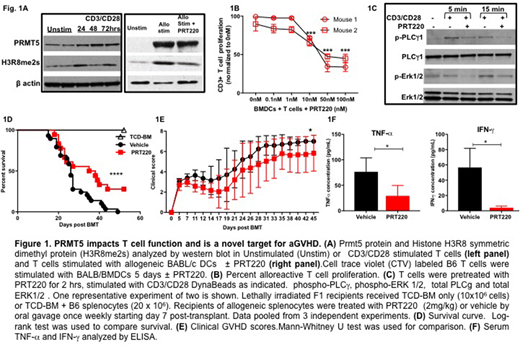Abstract
Introduction: Acute graft-versus-host disease (aGVHD), a T cell-mediated immunological disorder is the leading cause of non-relapse mortality in patients receiving allogeneic bone marrow transplants. Protein arginine methyltransferase 5 (PRMT5) catalyzes symmetric dimethylation (me2s) of arginine (R) residues on histones (primarily H3R8 and H3R4) and other proteins. PRMT5 is overexpressed in many leukemias and lymphomas, and epigenetic changes driven by PRMT5 lead to repression of tumor suppressors and promote growth and survival of cancer cells. Recently it was shown that T cells are sensitive to R-methylation and PRMT5 promotes activation of memory T helper cells. Here we investigate: 1) mechanisms by which PRMT5 regulates T cell function; and 2) PRMT5 inhibition as a therapeutic strategy for aGVHD.
Materials and Methods: Splenic T cells were isolated from lethally irradiated B6D2F1 mice that received either T cell depleted bone marrow (TCD-BM) or TCD-BM with C57/BL6 (B6) allogeneic splenocytes on day 21 post-transplant. In vitro activation of B6 T cells was achieved with CD3/CD28 Dynabeads or co-culture with allogeneic BM-derived dendritic cells. PRMT5 expression (RT-PCR, western blot) and function (H3R8me2s western blot) were evaluated. PRT220, a novel inhibitor of PRMT5, was used to evaluate PRMT5 inhibition on T cell function in vitro and in vivo. We assessed T cell proliferation (Cell Trace Violet, Ki67), apoptosis (Annexin V), cytokine secretion (ELISA, flow cytometry), cell cycle (PI incorporation), and cell signaling (western blot). Lethally irradiated F1 recipients received TCD-BM only (10x106 cells) or TCD-BM + B6 splenocytes (20 x 106). Recipients of allogeneic splenocytes were treated with PRT220 (2mg/kg) or vehicle by oral gavage once weekly starting day 7 post-transplant. Mice were monitored for survival and clinical aGVHD scores.
Results: PRMT5 expression and function is upregulated following T cell activation. Inhibition of PRMT5 reduces T cell proliferation and IFN-g secretion. PRMT5 inhibition in CD3/CD28 stimulated T cells results in disruption of multiple histone epigenetic marks, cell-cycle progression (via G1 arrest) and perturbation of ERK-MAPK signaling cascades. Finally, administration of PRT220 resulted in significantly prolonging the survival of allo-transplanted recipient mice (median survival, PRT220 vs. vehicle, 36.5 vs. 26 days, p=0.01). PRT220-treated recipients also exhibited significant lower aGVHD clinical (p<0.05), pathological scores (p<0.05) and lower serum TNF-a (p<0.05) and IFN-g (p<0.05) than vehicle-treated recipients.
Conclusions: PRMT5 expression and function are upregulated in activated T cells. Inhibition of PRMT5 function using a novel and specific small-molecule inhibitor, PRT220, down-regulates T cells proliferative and effector response, induces cell-cycle arrest and perturbs signaling pathways. PRT220 shows potent biological activity in vivo by reducing aGVHD clinical severity and significantly prolonging survival in mouse models of aGVHD. Therefore, PRMT5 is a novel and druggable target for aGVHD.
No relevant conflicts of interest to declare.
Author notes
Asterisk with author names denotes non-ASH members.


This feature is available to Subscribers Only
Sign In or Create an Account Close Modal